Pastors have their own brand of insider humor, just like doctors, lawyers, accountants and other skilled professionals.
The same is true for the missionaries, researchers and pastors who plant churches. Thus, Ed Stetzer once heard a veteran missions professor tell the following bittersweet joke at Southwestern Baptist Theological Seminary in Fort Worth, Texas.
It went like this: How do you start a new Southern Baptist church in a big city up north? That's easy. You go into local grocery stores and introduce yourself to all of the people who buy grits.
"The point, of course, is that this is what you do NOT want to do," said Stetzer, a native New Yorker who is president of LifeWay Research, linked to the 16-million-member Southern Baptist Convention. "If you're starting churches in places like New York City, those churches need to look like the indigenous churches that are already growing there.
"A successful church plant in Manhattan is obviously going to look a lot different than one in Alabama. ... We've known that for a long time, but we've learned a lot more since 9/11."
Stetzer was referring to a faith-shaped trend that has quietly emerged in the Big Apple in the decade since the twin towers fell.
Here's the statistic that insiders keep citing, drawn from a Values Research Institute (www.nycreligion.info) study: Forty percent of the evangelical Protestant churches in Manhattan were born after 2000, an increase of about 80. During one two-month stretch in 2009, at least one Manhattan church was planted every Sunday.
The impact has been big on one scale and tiny on another. According to the institute's research, the percentage of New Yorkers in center-city Manhattan who identify themselves as evangelical Protestants has, since 1990, risen from less than 1 percent to three percent. In other words, the evangelical population has tripled.
While even 3 percent of the people living in greater New York is a significant number, this small slice means that – from an evangelical Protestant viewpoint – missionaries still consider the city's population an "unreached people group" when compared with other regions. Thus, in 2003 the North American Mission Board of the Southern Baptist Convention pinned its "Strategic Focus City" label on New York, initiating a four-year project offering additional funds, volunteers and church-planting professionals.
It's impossible to tell this story without discussing the impact of 9/11, noted journalist Tony Carnes, who leads the Values Research Institute team. Rescue workers poured into New York City from across the nation, including volunteers from heartland churches not known for their affection for New York City.
"For the first time, to a large degree, important evangelical leaders realized that New York City was not what they thought it was," said Carnes. "They learned that you didn't need to walk down the street at night looking over your shoulder, worried that you were going to get shot. ...
"They also learned that there were already many evangelical churches here and that they were not weak, struggling and embattled. Many were strong, vital and growing."
The bottom line is that, while 9/11 was crucial, this story didn't start with 9/11.
Carnes stressed that 42 percent of the evangelical churches in the city's outer boroughs were founded between 1978 and 1999. This earlier surge was, in large part, driven by rapid growth in Pentecostal flocks led by African-Americans and Latinos. Another crucial event was the 1989 birth of Redeemer Presbyterian Church, led by the Rev. Tim Keller. Since then, teams from this Manhattan megachurch – which has attracted waves of Asian Christians – have planted 75 new churches across the city.
While it's easy to focus on the past decade, said Carnes, those striving to see the bigger picture need to study ongoing trends of among immigrants, young adults and others who continue, as they have for generations, to rush to New York City seeking changed lives and new opportunities.
New York, he said, remains America's great "unsettling city."
"New York is going to change you, whether you are from Texas or Africa," he said. "This city leaves you unsettled and that bring moments of pain and loneliness, but also moments that offer great freedom. ... Church leaders have started to realize that many of the people who keep arriving in this great city are seeking spiritual freedom, as well. They truly want to start over."



